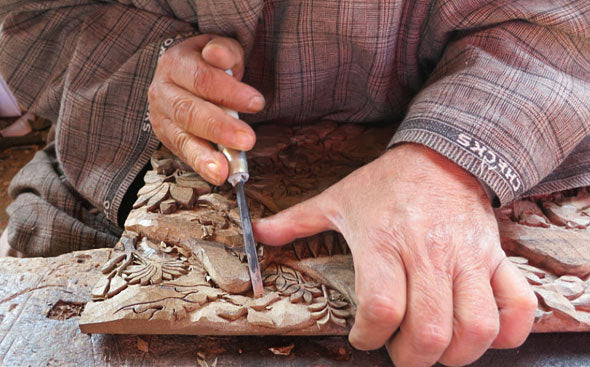
All About Walnut Wood Carving
Share
The walnut tree, called locally "Doon Kul," provides the raw material for the beautiful woodcarving of Kashmir. The tree is only chopped once it reaches the age of 300 years.
The city of Srinagar is the center of wood carving art. Walnut wood workshops may be found in the heart of Srinagar, where master carvers lean over the wood, chiseling and polishing.
The processes involved in walnut wood carving are joinery or carpentry, carving, and polishing, each with their own expert artisans.
The master carver, known as naqqash, begins by etching simple designs on the wood before subtly enhancing them using fine chisels and a wooden mallet to create an embossed surface. The carving of furniture and other delicate things is a complicated and intricate procedure that calls for the highest level of expertise and traditional workmanship. A kharkhana, or workshop, is run by an ustad, or master, who is accompanied by karigars.
Earlier, the karigars used to sing old Kashmiri compositions like sufia kalams, or other songs to keep themselves energised through the tedious process of carving. Gradually radio, and now smartphones, often dish out the music.

Struggle To Keep Walnut Wood Carving Going
Nowadays, walnut wood carving craftsmen face several challenges in Kashmir, such as the craftwork not producing enough cash, making it difficult for local craftsmen to continue the craft practice, and artists are concerned about the craft's future. With fewer students in walnut carving and fewer active karigars or artisans in Kashmir, current karigars find it challenging to fulfil the demand for wood-carved items.
To accommodate rising demand, shopkeepers in Kashmir collaborate with wood carving craftsmen in Saharanpur to bridge the supply-demand gap. The items from Saharanpur have contributed to the growing demand for Kashmiri souvenirs that are affordable to visiting tourists. Saharanpur, a town in western Uttar Pradesh, is also known for its beautiful wood carvings. These trades may be dated back to the late nineteenth century. The relationship and migration of Kashmiri artists in that area introduced Kashmiri patterns. These artisans were well-known for their distinctive jaali and vine leaf motifs.